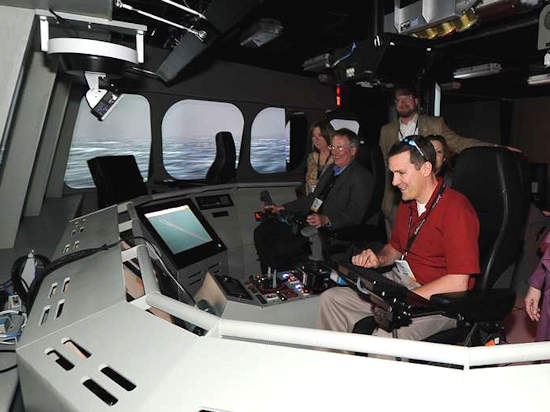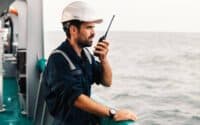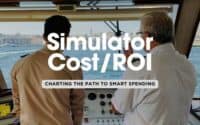Ship Training Simulators: A Beginners Rundown

Let’s dive into the fascinating world of Ship Training Simulators – or as I like to call it, the maritime metaverse.
What Are Ship Training Simulators?
Imagine stepping into a room and finding yourself on the bridge of a massive ship, or in the heart of its engine room – all without leaving dry land. That’s what these simulators are all about. They come in different flavors:
- Bridge Simulators: It’s like having the ship’s steering wheel in your hands. You get to navigate through everything from calm seas to the roughest storms.
- Engine Room Simulators: These are the tech-geek zones, where you dive into the nuts and bolts of what makes a ship tick.
- Full Mission Simulators: Here’s where you get the full deal – a bit of bridge action, some engine room drama, and a whole lot of learning.
How Do They Work?
These simulators are like high-tech video games. They replicate real-life scenarios that mariners face at sea. You get to steer through narrow channels, react to engine failures, or communicate in emergency situations – all in a day’s training. It’s not just about handling the equipment; it’s about making split-second decisions and staying cool under pressure.
Click here to find your Ideal Ship Training Simulator
Enhancing Safety Through Advanced Training
Alright, let’s hop into the next part of our journey with Ship Training Simulators and Maritime Shipping Simulators, focusing on how they ramp up safety through some pretty awesome training methods.
Risk-Free Training Environments
First off, Ship Training Simulators are like the ultimate safe spaces. They’re where mariners can practice dealing with tricky situations without the actual risk of being out at sea. Think of it as a sandbox for grown-ups. Whether it’s a fire in the engine room or a sudden storm while navigating, simulators let you tackle these challenges head-on. But here’s the cool part: make a mistake, and there’s no harm done. It’s all about learning in a space where it’s okay to trip up.
Realistic Scenario-Based Training
Maritime Shipping Simulators aren’t just about pushing buttons and turning wheels. They’re about recreating the unpredictable nature of the sea. We’re talking extreme weather, equipment going kaput, or navigating through the busiest of sea routes. This kind of training is like a rehearsal for the real deal. It preps sailors for those heart-racing moments, teaching them to make smart, quick decisions. Imagine facing a simulated mega-storm and figuring out the best way to sail through it – it’s intense, but it’s the best kind of practice!
Consistent and Standardized Training
Consistency is key with these simulators. Whether you’re training in Singapore or San Francisco, Ship Training Simulators ensure that the skills you learn are up to the mark, aligning with international standards. This is super important because it means that safety procedures and protocols are the same across the board. It’s like everyone’s singing from the same song sheet, which in the world of maritime safety, is a big deal. Standardized training also makes sure that whatever you learn is recognized and respected worldwide, keeping everyone on the same page when it comes to safety and efficiency.
In essence, Ship Training Simulators and Maritime Shipping Simulators are changing the game in maritime safety. They’re offering environments where mistakes become learning opportunities, where real-world scenarios are tackled head-on, and where consistency in training means a universally safer sea for all. It’s pretty groundbreaking stuff when you think about it!
Click here to find your Ideal Ship Training Simulator
The Future of Maritime Training and Safety
Alrighty, let’s talk about the future of maritime training and safety, where Ship Training Simulators and Maritime Shipping Simulators are steering the ship towards some pretty exciting horizons.
Technological Advancements in Simulation
In the world of simulation, things are getting super high-tech. We’re talking Virtual Reality (VR) and Artificial Intelligence (AI) joining the party. Imagine strapping on a VR headset and being on the deck of a ship, feeling the spray of the sea (okay, maybe not actually feeling it, but you get the idea). This kind of tech is taking training quality to a whole new level, making experiences more immersive and way more realistic.
AI, on the other hand, is like having a super-smart assistant that tailors your training. It adapts scenarios based on your performance, making sure you get practice where you need it most. The result? More personalized training that really hones your skills.
Integrating Simulators with Traditional Training Methods
Now, while Maritime Shipping Simulators are cool, they haven’t completely kicked old-school methods to the curb. There’s a balance. It’s about blending these high-tech simulators with hands-on deck experience and classroom learning. The best of both worlds, really. Best practices suggest using simulators as a complement to traditional methods – think of it as learning the theory in class, practicing it in the simulator, and then applying it on a real ship.
The Long-term Impact on Maritime Safety
To wrap it up, Ship Training Simulators and Maritime Shipping Simulators are more than just fancy tools – they’re game-changers in maritime safety. By offering risk-free, realistic, and standardized training, they’re preparing sailors like never before. And with the added spice of VR and AI, the future looks even brighter.
We’re talking about a future where maritime training is not just about learning the ropes (literally and figuratively) but mastering them in any scenario thrown your way. It’s about keeping the seas safer and making sure everyone who sets sail comes back to tell the tale. So, as we ride the wave of these advancements, it’s safe to say that the seas are becoming a safer place for all.
Additional References
VSTEP – Specializing in simulation software, VSTEP offers realistic 3D simulators for professional training. Their NAUTIS Maritime Simulator range is popular among maritime academies and individual shipowners for various training needs. Visit VSTEP
Transas – Now part of Wärtsilä Voyage, Transas provides integrated bridge systems, digital products, and electronic charts. They are known for their innovative ship simulator solutions and training services. Visit Transas
Kongsberg Maritime – A global company, Kongsberg Maritime offers a range of maritime solutions including ship design, marine simulators, deck machinery, and propulsion equipment. Their maritime simulators are renowned for their realism and advanced technologies. Visit Kongsberg Maritime
CM Labs Simulations – Known for their Vortex Studio software, CM Labs provides simulation-based solutions to enhance training, mission rehearsal, and equipment testing. They offer maritime simulators that are helpful for both commercial and government applications. Visit CM Labs Simulations
Marine Learning Systems – While primarily focused on e-learning solutions for the maritime industry, Marine Learning Systems also offers simulation-based training solutions. Their technology is used for training in various maritime operations and safety procedures. Visit Marine Learning Systems
7Seas Maritime – A comprehensive provider of simulation-based training solutions, 7Seas Maritime offers simulators for navigation, ship handling, and engine room operations. They cater to maritime academies and individual companies for customized training needs. Visit 7Seas Maritime
Buffalo Computer Graphics (BCG) – BCG offers maritime training solutions, including ship simulators for navigation, communication, and GMDSS (Global Maritime Distress and Safety System) training. Their products are used by maritime schools, government agencies, and navies around the world. Visit Buffalo Computer Graphics

Do you have a Maritime Product or Service that may be of interest to Shipowners? Tell us about it here!
Do you have feedback or insights? Please reach out to editor @ shipuniverse.com



